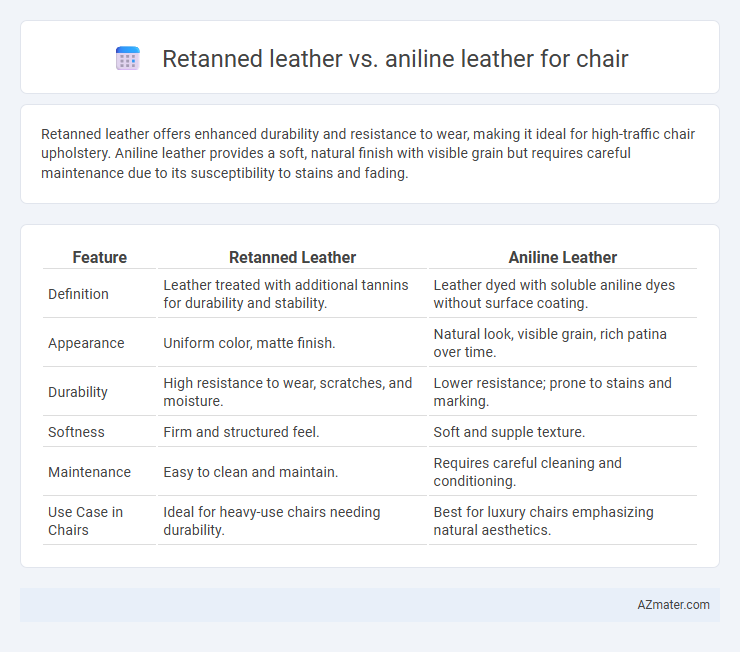Retanned leather offers enhanced durability and resistance to wear, making it ideal for high-traffic chair upholstery. Aniline leather provides a soft, natural finish with visible grain but requires careful maintenance due to its susceptibility to stains and fading.
Table of Comparison
| Feature | Retanned Leather | Aniline Leather |
|---|---|---|
| Definition | Leather treated with additional tannins for durability and stability. | Leather dyed with soluble aniline dyes without surface coating. |
| Appearance | Uniform color, matte finish. | Natural look, visible grain, rich patina over time. |
| Durability | High resistance to wear, scratches, and moisture. | Lower resistance; prone to stains and marking. |
| Softness | Firm and structured feel. | Soft and supple texture. |
| Maintenance | Easy to clean and maintain. | Requires careful cleaning and conditioning. |
| Use Case in Chairs | Ideal for heavy-use chairs needing durability. | Best for luxury chairs emphasizing natural aesthetics. |
Understanding Retanned Leather: Key Characteristics
Retanned leather for chairs undergoes a secondary tanning process that enhances durability, colorfastness, and resistance to moisture, making it ideal for heavy-use furniture. It features a thicker surface with a protective finish, offering better stain and scratch resistance compared to aniline leather, which remains untreated and showcases natural markings with a softer, more delicate feel. Retanned leather balances aesthetic appeal with practicality, providing long-lasting comfort and structural integrity for seating applications.
What is Aniline Leather? Core Features Explained
Aniline leather is a type of top-grain leather dyed exclusively with soluble aniline dyes, preserving its natural surface and grain without any pigment coating, resulting in a soft, breathable, and highly natural feel. Core features include enhanced softness, visible natural markings like pores and scars, and a rich depth of color that develops a unique patina over time. Unlike retanned leather, aniline leather lacks surface protection, making it more susceptible to stains and fading but prized for its authentic, luxurious appearance in chair upholstery.
Appearance & Aesthetic: Retanned vs. Aniline Leather
Retanned leather offers a more uniform and durable finish with enhanced color consistency, ideal for chairs requiring a polished and classic aesthetic. Aniline leather, prized for its natural look and softness, displays visible grain and imperfections, providing a rich, organic texture that develops character over time. The choice between retanned and aniline leather affects the chair's appearance significantly, balancing between a refined, resilient surface and a natural, luxurious patina.
Durability and Longevity Comparison
Retanned leather offers enhanced durability and resistance to wear due to its additional tanning process, making it ideal for chairs subjected to frequent use. Aniline leather, while prized for its natural look and softness, is more susceptible to stains and fading, requiring careful maintenance to preserve longevity. Choosing retanned leather for chairs ensures prolonged lifespan and sustained appearance, especially in high-traffic environments.
Comfort & Softness: How They Feel on Chairs
Retanned leather offers enhanced durability and a slightly firmer feel on chairs, providing moderate comfort with a consistent texture ideal for frequent use. Aniline leather features a softer, more natural feel due to its minimal surface coating, allowing the leather to breathe and mold comfortably to the body over time. The choice between retanned and aniline leather hinges on whether priority is given to long-lasting resilience or immediate plush softness in chair seating.
Stain Resistance and Maintenance Needs
Retanned leather offers enhanced stain resistance due to additional tanning processes that fill and coat the leather surface, making it easier to clean and maintain compared to aniline leather. Aniline leather, prized for its natural look and softness, remains more porous and prone to absorb stains, requiring cautious maintenance and specialized cleaners. For chairs, retanned leather provides a practical choice for high-traffic environments where durability and simplified upkeep are essential.
Color Options and Aging Process
Retanned leather offers a broader range of color options due to its additional dyeing and finishing treatments, making it ideal for chairs requiring vibrant or customized hues. Aniline leather retains its natural surface and ages gracefully by developing a rich patina over time, enhancing character without masking imperfections. While retanned leather is more resistant to staining and fading, aniline leather demands careful maintenance to preserve its appearance during the aging process.
Cost Differences: Retanned vs. Aniline Leather
Retanned leather typically costs less than aniline leather due to its additional tanning processes, which enhance durability and reduce production expenses. Aniline leather, known for its natural appearance and softness, commands a higher price because it undergoes minimal surface treatment, preserving the hide's natural texture and imperfections. When choosing chair upholstery, the cost difference reflects the balance between retanned leather's affordability and aniline leather's premium aesthetic qualities.
Best Use Cases: Which Leather for Which Chair?
Retanned leather offers durability and resistance to wear, making it ideal for high-traffic chairs such as office seating and family room furniture. Aniline leather, prized for its natural texture and soft feel, suits premium lounge chairs and executive office chairs where aesthetic appeal and comfort are prioritized. For chairs exposed to heavy use or spills, retanned leather provides practical longevity, while aniline leather enhances sophisticated environments with its rich, natural patina.
How to Choose: Factors to Consider for Your Chair
When choosing between retanned leather and aniline leather for a chair, consider durability, maintenance, and appearance. Retanned leather offers enhanced durability and resistance to stains, making it ideal for high-traffic use, while aniline leather provides a natural, soft feel with a more delicate surface that requires careful upkeep. Factors like daily use, exposure to sunlight, and preference for texture should guide the selection for optimal comfort and longevity.

Infographic: Retanned leather vs Aniline leather for Chair
 azmater.com
azmater.com